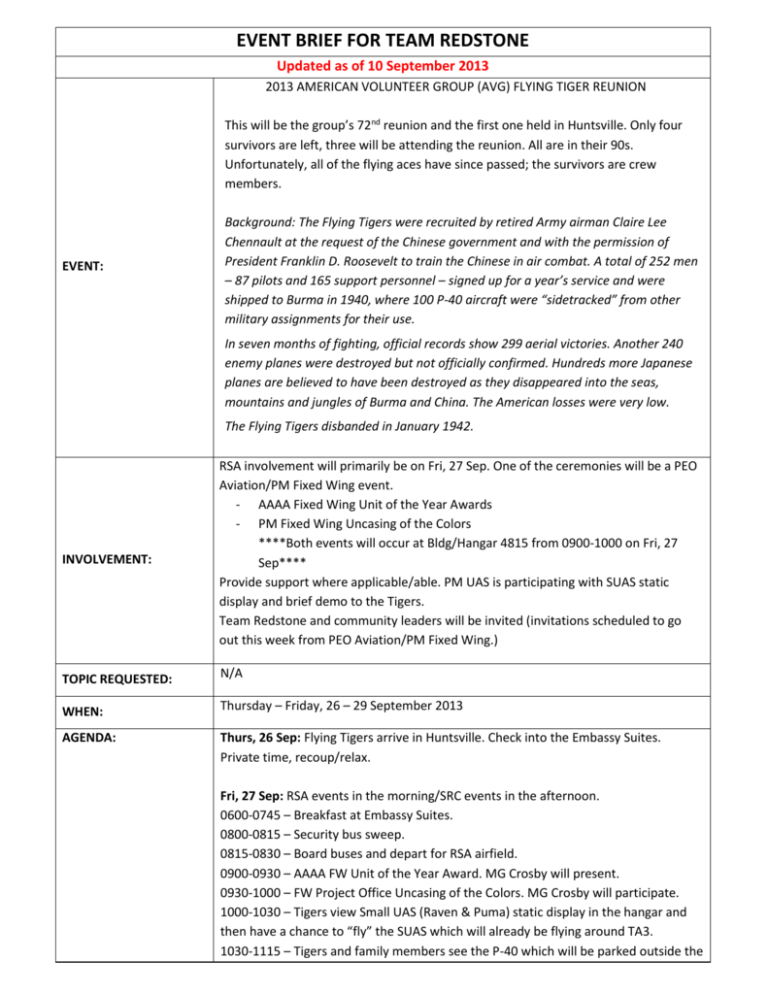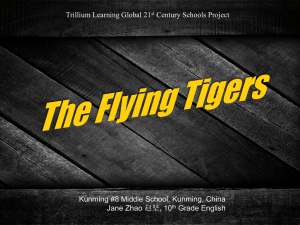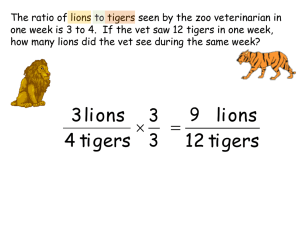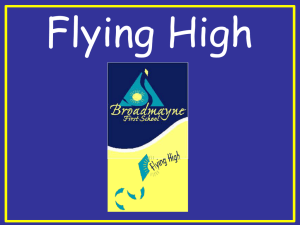Flying-Tigers-Reunion - Tennessee Valley Chapter AAAA
advertisement

EVENT BRIEF FOR TEAM REDSTONE Updated as of 10 September 2013 2013 AMERICAN VOLUNTEER GROUP (AVG) FLYING TIGER REUNION This will be the group’s 72nd reunion and the first one held in Huntsville. Only four survivors are left, three will be attending the reunion. All are in their 90s. Unfortunately, all of the flying aces have since passed; the survivors are crew members. EVENT: Background: The Flying Tigers were recruited by retired Army airman Claire Lee Chennault at the request of the Chinese government and with the permission of President Franklin D. Roosevelt to train the Chinese in air combat. A total of 252 men – 87 pilots and 165 support personnel – signed up for a year’s service and were shipped to Burma in 1940, where 100 P-40 aircraft were “sidetracked” from other military assignments for their use. In seven months of fighting, official records show 299 aerial victories. Another 240 enemy planes were destroyed but not officially confirmed. Hundreds more Japanese planes are believed to have been destroyed as they disappeared into the seas, mountains and jungles of Burma and China. The American losses were very low. The Flying Tigers disbanded in January 1942. INVOLVEMENT: RSA involvement will primarily be on Fri, 27 Sep. One of the ceremonies will be a PEO Aviation/PM Fixed Wing event. - AAAA Fixed Wing Unit of the Year Awards - PM Fixed Wing Uncasing of the Colors ****Both events will occur at Bldg/Hangar 4815 from 0900-1000 on Fri, 27 Sep**** Provide support where applicable/able. PM UAS is participating with SUAS static display and brief demo to the Tigers. Team Redstone and community leaders will be invited (invitations scheduled to go out this week from PEO Aviation/PM Fixed Wing.) TOPIC REQUESTED: N/A WHEN: Thursday – Friday, 26 – 29 September 2013 AGENDA: Thurs, 26 Sep: Flying Tigers arrive in Huntsville. Check into the Embassy Suites. Private time, recoup/relax. Fri, 27 Sep: RSA events in the morning/SRC events in the afternoon. 0600-0745 – Breakfast at Embassy Suites. 0800-0815 – Security bus sweep. 0815-0830 – Board buses and depart for RSA airfield. 0900-0930 – AAAA FW Unit of the Year Award. MG Crosby will present. 0930-1000 – FW Project Office Uncasing of the Colors. MG Crosby will participate. 1000-1030 – Tigers view Small UAS (Raven & Puma) static display in the hangar and then have a chance to “fly” the SUAS which will already be flying around TA3. 1030-1115 – Tigers and family members see the P-40 which will be parked outside the hangar. Photos/meet and greet. 1000-1130 – Audience opportunity to view the P-40, take photos, meet/greet the Tigers when available. 1115-1130 – Board bus and travel to the Overlook for lunch. 1130-1300 – Lunch at the Overlook (private lunch with family members and reunion registrants.) 1300-1400 – RSA windshield tour to be given my Mike Baker, Dan O’Boyle, and Sofia Bledsoe (there will be two buses). 1400 – Travel to Space and Rocket Center (SRC) for “Passing of the Torch”. (SRC event. AVG is working with Dr. Barnhart.) This is a FREE event and is open to the public. SRC requests that all interested register in their website http://www.spacecampstore.com/Flying-Tigers-Reunion-TIEVFTR13/ to account for seating. 1500 – Passing of the Torch ceremony. 1700 – Board buses and return to Embassy Suites. Sat, 28 Sep: Private time in the morning. Banquet in the evening. This event is open to the public. To register, contact Kim Quinn at kimberlyquinn@knology.net or (256) 652-4929. Registration deadline is 21 September. Cost is $60/person. 0700-1700 – Breakfast and free time. 0800 – AVG Flying Tigers Banquet in the Big Spring Ballroom. Post banquet / after dinner socializing Sun, 29 Sep: Farewells for now with old and new friends. Checkout and depart. AUDIENCE/DEMOGRAPH ICS: Calling all aviators, active duty and retired. Veterans of the Tennessee Valley Community; possible regional interest as well. Redstone Arsenal military organizations. Community leaders. VIPs: AVG Flying Tiger veterans and their families. Remaining survivors who will participate in the events are: 1. MSGT Charles “Chuck” Baisden, USAF (retired), AVG Armorer 2. Major Ed Stiles, Sr. USAFR (retired), AVG Crew Chief 3. Frank Losonsky, AVG Crew Chief MG William “Tim” Crosby, PEO Aviation, will present the FW Unit of the Year Award. LTG (ret) Dan Petrosky, former commander at Fort Rucker and past president of the Army Aviation Association of America, will attend the events and is the keynote speaker for the banquet. VIPs to be recognized at the ceremonies to follow. Uniform of the day for Fri, 27 Sep event. Business (coat & tie) and cocktail dress for Sat, 28 Sep event. DRESS/UNIFORM: NEWS MEDIA: Local news media will be invited to cover the RSA ceremonies at the airfield. SRC will invite media to the “Passing the Torch” event. SPONSOR/HOST: Kimberly Barnes Quinn 72nd AVG Flying Tiger Reunion organizer kimberlyquinn@knology.net 256-652-4929 (cell) 256-830-4194 (home) Kim’s husband, Matt Quinn, principal engineer at ComplexiQ, is the grandson of Flying Tiger Charles “Chuck” Baisden, 93, who lives in Savannah, Ga. Baisden was a mechanic and armorer for the Flying Tigers (American Volunteer Group-Chinese Air Force). At age 19, Baisden was the youngest member of the Flying Tigers. TVC AAAA is the main sponsor of the events through industry sponsorships. Those interested in donating should contact AAAA POC, Gary Nenninger at Gary.Nenninger@L-3com.com, (256) 704-9683 or Art Gribensk at art.gribensk@araneasolutions.com, (256) 715-9737 or (256) 924-0066. SRC POC is Ginny Langbehn, Director of Advancement at ginnyl@spacecamp.com, (256) 721-5409 or (256) 316-1234. Sofia Bledsoe: (O) 256.313.5468, (BB) 256.797.0607, sofia.bledsoe@peoavn.army.mil PUBLIC AFFAIRS SUPPORT: PM Fixed Wing POCs: Michele K. Erker, Operations Chief, (O) 256.955.6459, (BB) 256.652.9465, Michele.erker@us.army.mil Tracey Ayres, Communications/StratComm, (O) 256.876.5166, (C) 678-677-5373, tracey.e.ayres.ctr@mail.mil PM UAS POC: Marty Shelton, PM UAS Communications/StratComm, (O) 256.313.6452, (BB) 256.426.5420 Felicia Matthews: (O) 256-955-3633, evelyn.f.matthews.civ@mail.mil PROTOCOL SUPPORT: AUDIO VISUAL SUPPORT: COST: DIRECTIONS/PARKING: PM Fixed Wing/AFTD will provide for RSA events. There is no cost associated with the events the morning of 27 Sep (ceremonies at the airfield). There is no cost associated with the “Passing of the Torch” ceremony at the Space and Rocket Center. SRC requests that all interested register in their website http://www.spacecampstore.com/Flying-Tigers-Reunion-TIEVFTR13/ to account for seating. Main event is the 2013 AVG Flying Tiger Reunion banquet on Sat, 28 September at the Embassy Suites. Cost will be approx. $60 per person. To register, contact Kim Quinn, kimberlyquinn@knology.net or (256) 652-4929. Registration deadline is 21 September. For RSA ceremonies on 27 Sep, current plan is to bus attendees from the AFTD parking lot on Hale to the airfield hangar. PM Fixed Wing and AFTD are working together with AFTD on the parking plan for those attending. PM Fixed Wing attendees will be bused from their location off post to Redstone. Additional Notes: There will be two foreign nationals from the Chinese delegation who will be participating in the reunion events: 1. Sun Junkun, Secretary General of the Yunnan Flying Tigers Research Association 2. Xiang Li, colleague of Mr. Junkun (possibly also an interpreter) Currently working with PEO AVN Security and FDO to process clearance and obtain approval for installation access. The FNs have submitted information through their Chinese consulate, and we have copies of their visas. All FNs will have an escort while on Redstone provided by PM FW. No photography will be allowed during the windshield tour. HISTORY OF THE AVG FLYING TIGERS In April, 1937, Claire L. Chennault, then a captain in the United States Army Air Corps, retired from active duty and accepted an offer from Madame Chiang Kai-shek for a three month mission to China to make a confidential survey of the Chinese Air Force. At that time China and Japan were on the verge of war and the fledgling Chinese Air Force was beset by internal problems and torn between American and Italian influence. Madame Chiang Kai-shek took over leadership of the Aeronautical Commission in order to reorganize the Chinese Air Force. This was the beginning of Chennault's stay in China which did not terminate until 1945 at the close of World War II. Chennault's combat and other experiences between 1937 and 1941 in China are another story, but it was these experiences together with the knowledge he attained of combat tactics and the operations of Japanese Air Force over China that laid the ground work for the organization of the American Volunteer Group in 1941. It was during these years of self-imposed exile in the Chinese hinterland, that Chennault laid the foundation for the unique American air operations that featured the final three years of the Japanese war in China. In addition to his solid relations with Chinese of both high and low estate, these operations were based on clusters of strategically located air fields and an air-raid warning system that covered Free China. Without those three solid supports American air power could hardly have functioned in China. In discussing the genesis of the American Volunteer Group, Chennault states: "Methods of implementing the fighter-group plan developed faster than I expected. It became evident during the winter that China had a small but powerful circle of friends in the White House and Cabinet. Dr. Lauchlin Currie was sent to China as President Roosevelt's special adviser and returned a strong backer of increased aid to China in general and my air plans in particular. Another trusted adviser of the President-Thomas Corcoran-did yeoman service in pushing the American Volunteer Group project when the pressure against it was strongest." Concerning the A.V.G. combat statistics, Chennault says: "Although, the A.V.G. was blooded over China, it was the air battles over Rangoon that stamped the hallmark on its fame as the Flying Tigers. The cold statistics for the 10 weeks the A.V.G. served at Rangoon show its strength varied between twenty and five serviceable P-40's. This tiny force met a total of a thousand-odd Japanese aircraft over Southern Burma and Thailand. In 31 encounters they destroyed 217 enemy planes and probably destroyed 43. Our losses in combat were four pilots killed in the air, one killed while strafing and one taken prisoner. Sixteen P-40's were destroyed. During the same period, the R.A.F., fighting side by side with the A.V.G., destroyed 74 enemy planes, probably destroyed 33, with a loss of 22 Buffaloes and Hurricanes. In describing the genesis of the name "Flying Tigers" and the group's insignia, Chennault says: "Before I left the United States in the summer of 1941, I asked a few friends in Louisiana to watch the newspapers and send me any clippings about the A.V.G. Now I was being swamped with clippings from stateside newspapers, and my men were astonished to find themselves world famous as the Flying Tigers. The insignia we made famous was by no means original with the A.V.G. Our pilots copied the shark-tooth design on their P-40's noses from a colored illustration in the India Illustrated Weekly depicting an R.A.F. squadron in the Libyan Desert with shark-nose P-40's. Even before that the German Air Force painted shark's teeth on some of its Messerschmitt 210 fighters. With the pointed nose of a liquid cooled engine it was an apt and fearsome design. How the term Flying Tigers was derived from the shark-nosed P-40's I never will know. At any rate we were somewhat surprised to find ourselves billed under that name. It was not until just before the A.V.G. was disbanded that we had any kind of group insignia. At the request of the China Defense Supplies in Washington, the Walt Disney organization in Hollywood designed our insignia consisting of a winged tiger flying through a large V for victory." President Roosevelt then sent Curtiss P-40 Tomahawks to the Chinese under the American Lend-Lease program. Chennault also was able to recruit some 300 American pilots and ground crew, posing as tourists, who were adventurers or mercenaries, not necessarily idealists out to save China. But under Chennault they developed into a crack fighting unit, always going against superior Japanese forces. They became the symbol of America's military might in Asia. In April, 1942, President Franklin D. Roosevelt wrote of the American Volunteer Group: "The outstanding gallantry and conspicuous daring that the American Volunteer Group combined with their unbelievable efficiency is a source of tremendous pride throughout the whole of America. The fact that they have labored under the shortages and difficulties is keenly appreciated . . . " After the American Volunteer Group was disbanded on July 4, 1942, the China Air Task Force of the United States Army Air Forces, commanded by General Chennault, officially took over air operations in China. In early March, 1943, the 14th Air Force was activated under the command of Chennault and replaced the China Air Task Force. Chennault remained in command of the 14th Air Force until the end of July, 1945. General Chennault formally retired from the military for the second time in October, 1945. ABOUT THE ALEUTIAN TIGER | P-40K WARHAWK The P-40 was a fighter and ground attack aircraft that was first produced in 1938 at the Curtiss Wright Corporation facility in Buffalo, New York. The P-40 design was an outgrowth of the pre-war Curtiss P-36. The Warhawk eventually saw service with 28 nations and was used by most of the Allied powers in WWII. The Warhawk was sold to Britain, Russia and other Commonwealth nations. Its primary users were the U.S. Army Air Forces, the Royal Air Force, the Royal Canadian Air Force and the Royal Australian Air Force. The USAAF adopted the name Warhawk while the British named it the Tomahawk (P-40 models B & C) and then changed the name to Kittyhawk for the model P-40D and later variants. During the war, the allocation of limited raw materials, such as tungsten, prevented the P-40 from receiving the two-stage supercharger which the P-51 Mustang received. This limited its capabilities at high altitudes against the superior Luftwaffe fighters – which restricted it to rare use by the British in Northwest European operations. The P-40 played a significant role with the United States Army Air Forces in North Africa, Italy, the Southwest Pacific and the China-Burma-India theater. The P-40 became famous for its role with the American Volunteer Group in China – also known as the Flying Tigers – later absorbed by the 14th Air Force. The Flying Tigers made the “shark mouth” famous, however, the Royal Air Force’s Number 112 Squadron was the first to feature this paint scheme. The P-40 that you see here represents the “Aleutian Tigers,” i.e. the 343rd Fighter Group activated on September 11, 1942 and operated in Alaska until the fall of 1943. They flew with the U.S. Navy, the Royal Canadian Air Force and other USAAF units throughout the Aleutian Island chain. The “Aleutian Tigers” have a few figurative and similar connections to the “Flying Tigers” that flew in China: both groups flew the P-40; the “Aleutian Tigers” were commanded by Lt. Col. John “Jack” Chennault, the son of General Claire Chennault who commanded the “Flying Tigers” in China; finally the distinctive tiger face on the Alaskan aircraft was a take off from the original “Flying Tigers” that operated in China. The P-40 was equipped with the same engine used in the P-38, the P-39 and the early versions of the P-51 (the Allison 12 cylinder V-1710). Designed by Donovan Berlin, it first flew on October 14th, 1938. There were 13,738 produced from 1938 until 1944; produced at a unit cost of $44,892 in 1944. The P-40 tolerated harsh extremes in many climates and offered the advantage of a low cost aircraft which kept it in production long after it ordinarily would have been considered obsolete. The P-40 played a significant role in winning the war. ###





